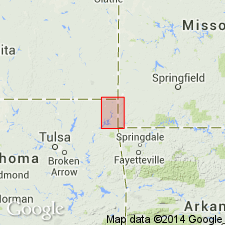
- Usage in publication:
-
- Baxter Springs Member*
- Modifications:
-
- Original reference
- Dominant lithology:
-
- Limestone
- Chert
- AAPG geologic province:
-
- Chautauqua platform
- Cherokee basin
Summary:
Pg. 40-50. Baxter Springs Member of Boone Formation. Chiefly glauconitic limestone and chert. Subdivided into (descending): (1) J bed, thin phosphatic and highly glauconitic crinoidal limestone containing variegated and, in part, very dark chert, 0 to 5 feet thick; (2) K bed, crinoidal glauconitic limestone and variegated chert, 0 to 51 feet thick; and (3) L bed, pale chert or cotton rock (or tripoli), glauconitic at base, 0 to 60 feet thick. Conformably overlies Short Creek Oolite Member and conformably underlies Moccasin Bend Member, both of the Boone Formation. Fossils. Age is Late Mississippian (Meramec).
Type section: west bluff of Spring River, [in NE/4 sec. 16, T. 29 N., R. 25 E., Peoria 7.5-min quadrangle], Ottawa Co., OK, about 1,000 ft south of KS-OK State line and 2 mi south of Baxter Springs, Cherokee Co., KS.
Source: US geologic names lexicon (USGS Bull. 1520, p. 21); GNU records (USGS DDS-6; Denver GNULEX).
For more information, please contact Nancy Stamm, Geologic Names Committee Secretary.
Asterisk (*) indicates published by U.S. Geological Survey authors.
"No current usage" (†) implies that a name has been abandoned or has fallen into disuse. Former usage and, if known, replacement name given in parentheses ( ).
Slash (/) indicates name conflicts with nomenclatural guidelines (CSN, 1933; ACSN, 1961, 1970; NACSN, 1983, 2005, 2021). May be explained within brackets ([ ]).

